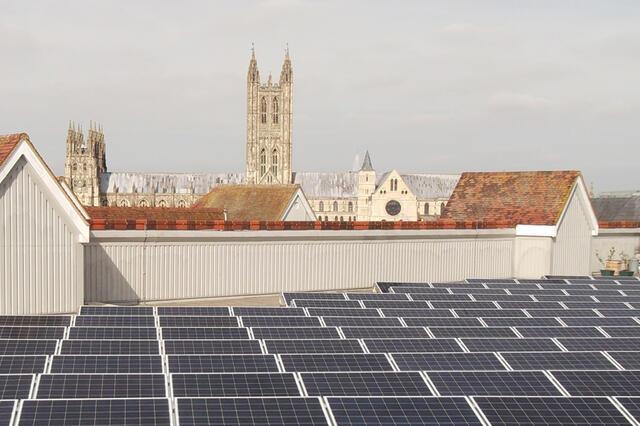TH Real Estate’s PV Installation at Whitefriars
17 December 2015TH Real Estate’s PV Installation at Whitefriars
17 December 2015TH Real Estate installed solar panels on Whitefriars Shopping Centre in Canterbury in 2013. This PV (photovoltaic) array is helping to future proof the centre against energy price rises and supply shortages, generating renewable energy, cutting CO2 emissions, reducing energy costs for occupiers and delivering a stable income stream for TH Real Estate.
Key Facts
- 90,000 kWh of renewable energy each year
- 94 tonnes less CO2 since 2013
- £40,100 income and savings for TH Real Estate
- 20% discount on electricity costs for occupiers
Situation
TH Real Estate is an investment management company, specialising in real estate investment worldwide. TH Real Estate’s Responsible Property Investment (RPI) programme includes energy, water and recycling targets, benchmarking and annual asset sustainability action plans. Whitefriars Shopping Centre is a 55,000 m2 open shopping district in the heart of the city of Canterbury.
Drivers for the Whitefriars PV installation included:
- Supporting TH Real Estate’s RPI programme, cutting CO2 emissions and generating financial benefits for TH Real Estate and its occupiers.
- Whitefriars was a strong option for PV as it has a substantial roof area, significant energy consumption on site and is located in Kent, which benefits from high solar levels. In addition, TH Real Estate controls the roof space.
Actions
TH Real Estate commissioned Syzygy Renewables to complete the planning submissions, National Grid application and technical specifications, and to project manage the tendering process and installation period. Ardenham Energy won the contract to supply and install the panels. The team worked with the Whitefriars Centre Manager throughout
Two PV arrays were installed at Whitefriars in 2013:
- 50 kWp supplying the common parts, with energy bills paid by occupiers through the service charge.
- 47 kWp connected to the car park lighting, an area where the property owner pays for energy supplies that are non-recoverable through the service charge.
In addition to the PV arrays, which reduce National Grid electricity use on site, initiatives to improve energy efficiency at Whitefriars include replacing traditional light fittings with LED alternatives across the car park, service corridors, basements and customer toilets. Savings on electricity bills, lighting replacement costs and maintenance will deliver payback on the £171,000 investment in LED replacements within three years.
Benefits and financials
TH Real Estate’s UK Shopping Centre Fund invested £148,000 in PV at Whitefriars, including all surveys, installation fees and associated costs, with forecast payback within eight years.
Results to November 2015 include:
- £40,100 income and savings for TH Real Estate, comprising £9,700 savings on car park electricity costs, £9,200 income on electricity for common parts and £21,200 from Government Feed-In Tariffs.
- 20% discount for occupiers on renewable electricity versus National Grid rates, delivering service charge savings of £2,300.
- 94 tonnes of CO2 saved.
- 100% of the renewable energy generated used on site, increasing returns as the cost savings on reduced consumption of National Grid electricity are greater than revenue generated by exporting the same amount of electricity to the National Grid.
Challenges and Achievements
PLANNING
How to get planning consent for PV in a conservation area?
In 2013, full planning applications were required for PV and there were particular sensitivities at Whitefriars as the Centre is close to Canterbury Cathedral. The team therefore held discussions with Canterbury City Council’s planning team early on and ensured that the installation design minimised impacts on the conservation area. Panels are carefully positioned, so they have no visual impact from the ground, concealed by the roof’s parapet walls. The panels are also dark blue/black, so they do not reflect light, and have no moving parts, so they do not generate noise. The planning application outlined all these measures, as well as referencing national and local policy supporting small scale renewable energy technologies. Consent was granted in 2013.
MANAGEMENT
How to ensure PV installations run smoothly?
Every project is different and it is advisable for the team to include someone with experience of PV installations. For instance, different providers can come back with very different solutions for the same roof area and it can be difficult to identify the best option. It is also important to consider a range of factors, such as how the generating capacity matches with demand on site, with the greatest returns tending to come where there are both large roof areas and significant electricity consumption on site. It is also important to consider the loading capacity of the roof and the distance to the connection point, which can affect costs. At Whitefriars, TH Real Estate brought in Syzygy Renewables, which has experience across around 120 projects, including several shopping centres. The Centre Manager also led the project on the ground, dealing with the practical requirements of the installer and ensuring that no disruption was caused to occupiers. The installations, which ran to time, took around a month.
TECHNICAL
How did the team address specific technical challenges at Whitefriars?
There were a few technical challenges at Whitefriars. On the car park roof, the PV array needed to be installed on top of an existing plant screen due to space constraints. However, this screen would not provide the required stability for the PV panels. Syzygy and Ardenham therefore developed a secondary framing system that could be placed on top of the plant screen. In addition, the common parts PV array was installed on a relatively lightweight roof, which affected design and framing. Finally, the design ensured that panels subject to shading could be ‘knocked out’, as the loss of one panel to shading could otherwise result in the loss of output across a large section.
Find out more
Jenny Pidgeon
Head of Sustainability
TH Real Estate
www.threalestate.com
*Please note that the information on this page was supplied by the BBP Member and the BBP assumes no responsibility or liability for any errors or omissions in the content

